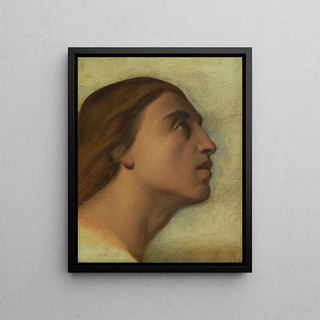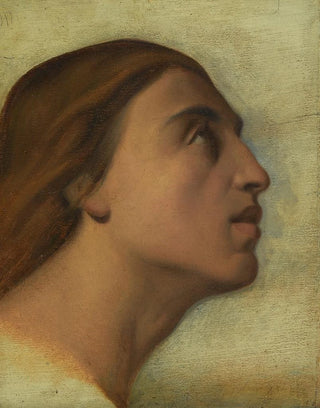Art print | Study of the head of Saint John the Evangelist seen in profile - Jean-Hippolyte Flandrin


View from behind

Frame (optional)
Reproduction of the Head Study of Saint John the Evangelist in profile - Jean-Hippolyte Flandrin – Captivating introduction
The "Head Study of Saint John the Evangelist in profile" by Jean-Hippolyte Flandrin is a masterpiece that embodies the very essence of spirituality through art. This drawing, executed with remarkable precision, demonstrates the artist's ability to capture not only the form but also the soul of the depicted figure. Focusing on the profile of Saint John, Flandrin invites the viewer to a profound contemplation, a reflection on divine and human nature. The light gently caressing the saint's features, the subtle shadows highlighting his face, create an atmosphere that is both serene and mysterious.
Style and uniqueness of the work
Flandrin's style is distinguished by its realism and finesse. Every line, every curve of Saint John's face is drawn with a precision that seems almost alive. The artist skillfully plays with contrasts of light and shadow, giving his subject unparalleled emotional depth. This art print is not limited to a simple representation; it becomes an exploration of human emotions, a quest for spiritual beauty. The expression of the saint, both contemplative and serene, evokes feelings of inner peace and wisdom. Through his delicate and thoughtful approach, Flandrin manages to transcend the simple portrait to offer the viewer a true aesthetic and spiritual experience.
The artist and his influence
Jean-Hippolyte Flandrin, an emblematic figure of the 19th century, left an indelible mark on the art world. A student of the École des Beaux-Arts in Paris, he mastered the balance between tradition and innovation, drawing inspiration from old masters while developing his own sensitivity. His work, marked by deep reflection on spirituality and humanity, influenced many contemporary artists and paved the way for future movements. Flandrin was also a pioneer in the use of color and light, which gave his works an almost mystical dimension. By exploring religious themes with such intensity

Matte finish

View from behind

Frame (optional)
Reproduction of the Head Study of Saint John the Evangelist in profile - Jean-Hippolyte Flandrin – Captivating introduction
The "Head Study of Saint John the Evangelist in profile" by Jean-Hippolyte Flandrin is a masterpiece that embodies the very essence of spirituality through art. This drawing, executed with remarkable precision, demonstrates the artist's ability to capture not only the form but also the soul of the depicted figure. Focusing on the profile of Saint John, Flandrin invites the viewer to a profound contemplation, a reflection on divine and human nature. The light gently caressing the saint's features, the subtle shadows highlighting his face, create an atmosphere that is both serene and mysterious.
Style and uniqueness of the work
Flandrin's style is distinguished by its realism and finesse. Every line, every curve of Saint John's face is drawn with a precision that seems almost alive. The artist skillfully plays with contrasts of light and shadow, giving his subject unparalleled emotional depth. This art print is not limited to a simple representation; it becomes an exploration of human emotions, a quest for spiritual beauty. The expression of the saint, both contemplative and serene, evokes feelings of inner peace and wisdom. Through his delicate and thoughtful approach, Flandrin manages to transcend the simple portrait to offer the viewer a true aesthetic and spiritual experience.
The artist and his influence
Jean-Hippolyte Flandrin, an emblematic figure of the 19th century, left an indelible mark on the art world. A student of the École des Beaux-Arts in Paris, he mastered the balance between tradition and innovation, drawing inspiration from old masters while developing his own sensitivity. His work, marked by deep reflection on spirituality and humanity, influenced many contemporary artists and paved the way for future movements. Flandrin was also a pioneer in the use of color and light, which gave his works an almost mystical dimension. By exploring religious themes with such intensity






